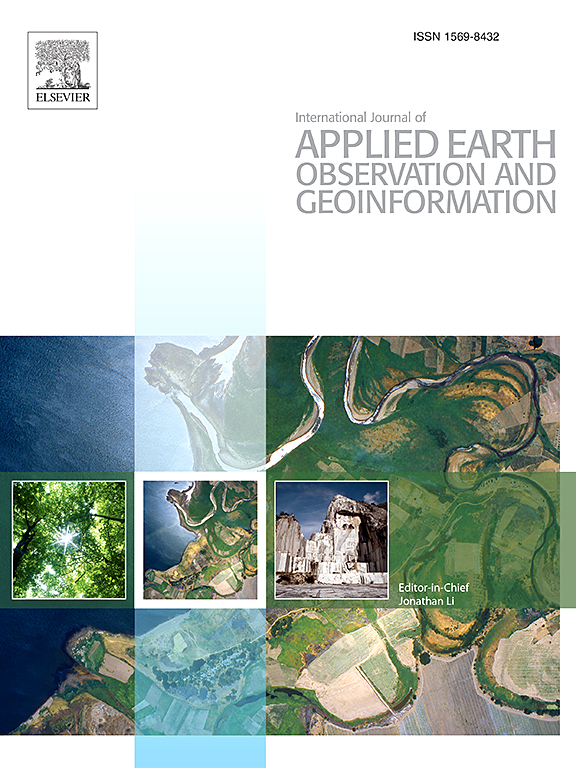Model morphing supported large scale crop type mapping: A case stuy of cotton mapping in Xinjiang, China
IF 7.6
Q1 REMOTE SENSING
International journal of applied earth observation and geoinformation : ITC journal
Pub Date : 2025-06-16
DOI:10.1016/j.jag.2025.104667
引用次数: 0
Abstract
Long-term, large-scale crop distribution mapping is crucial for agricultural policy and resource management. While high-resolution multispectral remote sensing has been widely used for crop type mapping, three major challenges remain: 1) spatiotemporal heterogeneity in cloud-free and shadow-free observations, 2) the lack of sufficient ground truth samples, and 3) limited generalization of identification models over extended periods. To address these challenges, this paper constructs a time-continuous sequence model that captures the unique feature pattern between the target-crop and non-target crops (referred to as the knowledge model). Specifically, a morphing approach was first employed to interpolate intermediate models between two pre-trained non-adjacent knowledge models. Then, a date-continuous sequence model that estimate the probabilistic of growth patterns of target crop was generated. This date-continuous sequence model mitigates spatiotemporal heterogeneity issues at the pixel level across large regions. Additionally, crop-specific knowledge model addresses sample scarcity and enhances generalization during long-term applications. The method was test using a long-term cotton mapping task (2000, 2005–2023) in Xinjiang, China. The results demonstrate that: 1) The sequence of knowledge model can effectively capture feature differences between cotton and non-cotton throughout the growing period, resulting in knowledge feature has a higher separability compared to original spectral and vegetation index features; 2) Segmenting knowledge features with Unet enables effective mapping cotton and non-cotton without ground samples. The estimated planting area from our mapping results shows excellent consistency with official statistics (R2 = 0.97). The correlation between our 2018–2021 results and previously published data reached 0.8, 0.88, 0.88, and 0.89. 3). The stable and excellent mapping accuracy proves that resonation of connectivity and reachability in parameter space between two networks with identical architecture, and model morphing is a feasible way to overcome the spatial–temporal heterogeneity in valid observations in large regions.
模型变形支持大比例尺作物类型制图——以新疆棉花制图为例
长期、大规模的作物分布图对农业政策和资源管理至关重要。虽然高分辨率多光谱遥感已广泛应用于作物类型制图,但仍存在三个主要挑战:1)无云和无阴影观测的时空异质性;2)缺乏足够的地面真值样本;3)识别模型在长时间内的泛化程度有限。为了解决这些问题,本文构建了一个捕获目标作物和非目标作物之间独特特征模式的时间连续序列模型(称为知识模型)。具体而言,首先采用变形方法在两个预训练的非相邻知识模型之间插入中间模型。然后,建立了目标作物生长模式概率估计的数据连续序列模型。该数据连续序列模型缓解了大区域像素水平上的时空异质性问题。此外,特定作物知识模型解决了样本稀缺性问题,提高了长期应用中的泛化能力。该方法在中国新疆的长期棉花制图任务(2000,2005 - 2023)中进行了测试。结果表明:1)知识模型序列能够有效捕捉棉花与非棉花在整个生育期的特征差异,使知识特征比原始光谱特征和植被指数特征具有更高的可分性;2)利用Unet对知识特征进行分割,可以在没有地面样本的情况下进行棉花和非棉花的有效测绘。估算的种植面积与官方统计数据具有良好的一致性(R2 = 0.97)。我们2018-2021年的结果与之前公布的数据之间的相关性为0.8、0.88、0.88和0.89。3). 稳定而优异的映射精度证明了具有相同结构的两个网络在参数空间上的连通性和可达性的共振,以及模型变形是克服大区域有效观测的时空异质性的可行方法。
本文章由计算机程序翻译,如有差异,请以英文原文为准。
求助全文
约1分钟内获得全文
求助全文
来源期刊

International journal of applied earth observation and geoinformation : ITC journal
Global and Planetary Change, Management, Monitoring, Policy and Law, Earth-Surface Processes, Computers in Earth Sciences
CiteScore
12.00
自引率
0.00%
发文量
0
审稿时长
77 days
期刊介绍:
The International Journal of Applied Earth Observation and Geoinformation publishes original papers that utilize earth observation data for natural resource and environmental inventory and management. These data primarily originate from remote sensing platforms, including satellites and aircraft, supplemented by surface and subsurface measurements. Addressing natural resources such as forests, agricultural land, soils, and water, as well as environmental concerns like biodiversity, land degradation, and hazards, the journal explores conceptual and data-driven approaches. It covers geoinformation themes like capturing, databasing, visualization, interpretation, data quality, and spatial uncertainty.
 求助内容:
求助内容: 应助结果提醒方式:
应助结果提醒方式:


